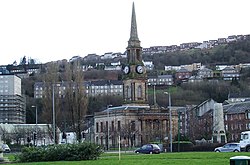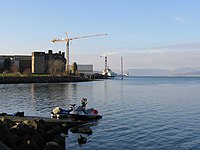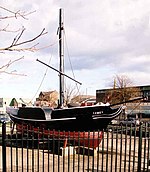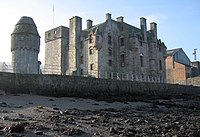Port Glasgow: Difference between revisions
| Line 25: | Line 25: | ||
==History== | ==History== | ||
[[File:Newark Castle and Clyde.jpg|left|thumb|200px|Newark Castle, by the last shipyard on the Lower Clyde]] | [[File:Newark Castle and Clyde.jpg|left|thumb|200px|Newark Castle, by the last shipyard on the Lower Clyde]] | ||
Port Glasgow was originally a small village known as '''Newark''', whose name ''newerk'' referred to the castle newly built there by the Maxwells. Trading ships from | Port Glasgow was originally a small village known as '''Newark''', whose name ''newerk'' referred to the castle newly built there by the Maxwells. Trading ships from France and the Low Countries were unloaded at Newark and the cargo was brought up the [[River Clyde]] to [[Glasgow]] on smaller boats. | ||
In 1667, the town council of Glasgow purchased land for the construction of a harbour and breakwater. This became Glasgow's first deep-water port and the town of Newark became known as Port Glasgow (on some eighteenth century maps it is shown as ''Newport Glasgow''). After 1693, the grid-iron street layout which still forms much of the town centre today, was laid out. | In 1667, the town council of Glasgow purchased land for the construction of a harbour and breakwater. This became Glasgow's first deep-water port and the town of Newark became known as Port Glasgow (on some eighteenth century maps it is shown as ''Newport Glasgow''). After 1693, the grid-iron street layout which still forms much of the town centre today, was laid out. | ||
Latest revision as of 19:01, 7 November 2014
| Port Glasgow | |
| Renfrewshire | |
|---|---|
 Port Glasgow | |
| Location | |
| Grid reference: | NS321746 |
| Location: | 55°56’24"N, 4°41’24"W |
| Data | |
| Population: | 16,617 (2001) |
| Post town: | Port Glasgow |
| Postcode: | PA14 |
| Dialling code: | 01475 |
| Local Government | |
| Council: | Inverclyde |
| Parliamentary constituency: |
Inverclyde |
Port Glasgow is a large, industrial port town in Renfrewshire. It was founded, as the name suggests, as a port on the River Clyde serving the city of Glasgow, though it was not founded as such in the Industrial Revolution but dates back to the seventeenth century.
Port Glasgow stands immediately to the east of another important Renfrewshire Clyde port, Greenock. The population according to the 1991 census for Port Glasgow was 19,426 though in the 2001 census that has declined to 16,617.
The town grew from the central area of the present town and thus many of the town's historic buildings are found here. Port Glasgow expanded up the steep hills inland to open fields where areas such as Park Farm, Boglestone and Devol were founded. This area has subsequently become known as Upper Port Glasgow and most of the town's population occupies these areas.
The town is served by Port Glasgow railway station (main station) in the town centre and Woodhall railway station on the east of the town.
History

Port Glasgow was originally a small village known as Newark, whose name newerk referred to the castle newly built there by the Maxwells. Trading ships from France and the Low Countries were unloaded at Newark and the cargo was brought up the River Clyde to Glasgow on smaller boats.
In 1667, the town council of Glasgow purchased land for the construction of a harbour and breakwater. This became Glasgow's first deep-water port and the town of Newark became known as Port Glasgow (on some eighteenth century maps it is shown as Newport Glasgow). After 1693, the grid-iron street layout which still forms much of the town centre today, was laid out.
Shipbuilding
By the 19th century, Port Glasgow had become a centre of shipbuilding. The Comet was built in the town in 1812 and was the first commercial steam vessel in Europe. A replica of the Comet and a plaque commemorating the actual site of construction are situated in Port Glasgow town centre.

Port Glasgow became a burgh in 1833, but around this time, the River Clyde up to Glasgow was deepened and new road and rail links meant that the town was no longer needed much as a port. The shipbuilding industry then took over as the main source of employment and prosperity. Port Glasgow has been responsible for about a quarter of the total tonnage of ships launched on the Clyde. However like the rest of Inverclyde this industry has all but gone and only Ferguson Shipbuilders yard remains in the town today and is one of the last privately owned shipyards left in Scotland.
Sights of the town
Newark Castle

Newark Castle stands very close to the shore of the Clyde, and dates to around 1484. It was home to the Maxwell Family, but they no longer lived in the castle after 1694. By 1800 the castle was surrounded by shipyards, but today only Fergusons shipyard survives, standing close to the west of the castle, and an open park area and waterfront walkway have been landscaped to the east.
The castle is now a visitor attraction maintained on behalf of the nation by Historic Scotland.
Parklea
Adjacent to the castle and its surrounding park, several acres of the Clyde foreshore at Parklea are owned by the National Trust for Scotland. For many years the land has been leased to the local authority as playing fields. When the NTS acquired the land it was regarded as protecting the foreshore from the widespread acquisition by shipyards.